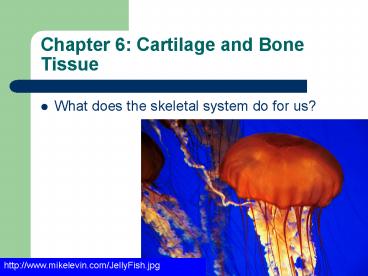Chapter 6: Cartilage and Bone Tissue - PowerPoint PPT Presentation
1 / 31
Title:
Chapter 6: Cartilage and Bone Tissue
Description:
Costal cartilage. Intervertebral disks. Pubic symphysis. Embryonic ... Costal cartilages. Network of collagen fibers (6.1) Elastic Cartilage. Elastic fibers ... – PowerPoint PPT presentation
Number of Views:134
Avg rating:3.0/5.0
Title: Chapter 6: Cartilage and Bone Tissue
1
Chapter 6 Cartilage and Bone Tissue
- What does the skeletal system do for us?
http//www.mikelevin.com/JellyFish.jpg
2
Cartilage
- Location
- Ear and nose
- Respiratory system
- Movable joints
- Costal cartilage
- Intervertebral disks
- Pubic symphysis
- Embryonic
(6.1)
3
Cartilage Tissue
- Specialized CT
- Chondrocytes in lacunae
- Solid ground substance and fibers
- Avascular
- No nerves
- Perichondrium
- 60-80 water resilient
4
Hyaline Cartilage
- Most abundant
- Locations
- Joints
- Trachea
- Costal cartilages
- Network of collagen fibers
(6.1)
5
Elastic Cartilage
- Elastic fibers
- Locations
- External ear
- Epiglottis
6
Fibrocartilage
- Bundles of collagen fibers in rows
- Locations
- Intervertebral disks
- Pubic symphysis
- Menisci
7
Cartilage Growth
- Appositional growth
- From perichondrium
- Interstitial growth
- By chondrocytes within cartilage
- No new chondrocytes in adults and no cartilage
growth
8
Bone Functions
- Support body weight
- Protect soft organs
- Movement at joints
- Storage of Ca and PO4-3
- Hematopoiesis
(6.2)
9
Bone Shapes
- Long bones extremities
- Short bones cube-shaped, wrist ankle
- Flat bones skull, sternum, scapula, ribs
- Irregular bones vertebrae, pelvis
(6.2)
10
Compact vs. Spongy Bone
- Compact solid, weight-bearing, structural
support - Spongy marrow cavity, trabeculae, light weight
(6.3ab)
11
Compact vs. Spongy Bone
Medullary cavity
See Fig. 6.5b
12
Long Bones
- Diaphysis shaft
- Epiphyses ends
- Epiphyseal plate/line growth region
- Nutrient arteries to marrow and compact bone
(6.3ac)
13
Periosteum
- Fibrous layer dense irregular CT
- Cellular layer osteoblasts osteoclasts
- Nerves
- Blood vessels
- Sharpeys fibers
- Attachment for tendons
(6.3c)
(6.6a)
14
Endosteum
- Inner surface of compact bone
- Covers trabeculae
- Osteoblasts osteoclasts
(6.3b)
15
Flat Bone
- Skull
- Two sheets of compact bone
- Diploe spongy bone
(6.4)
16
Compact Bone Histology
(6.7)
- Osteon / Haversian system
- Structural unit of long bone
- Cylindrical
- Parallel to bone
- Concentric lamellae
- Collagen fibers in different directions
- Increase strength
(6.6a)
17
Compact Bone Histology
- Interstitial lamellae
- Circumferential lamellae
- Inner outer
18
Compact Bone Histology
- Central / Haversian Canals
- Perforating / Volkmanns Canals
- Endosteum
- Blood vessels
- Nerves
(6.6a)
19
Osteocytes
4.12j
- Located within lacunae (cavities) in lamellae
- Canaliculi allow processes of osteocytes to
communicate with each other with capillaries
(6.6b)
20
Spongy Bone
- Lamellae
- Osteocytes
- Endosteum
(6.3b)
See 6.8b
21
Bone Composition
- 35 cells, fibers (collagen), ground substance
- 65 mineral salts, mainly calcium phosphate
precipitated around collagen fibers
See 6.8b
22
Bone Formation
- Osteogenesis development of the skeleton and
growth through adolescence (18 females, 21
males) - Osteoblasts secrete osteoid
- Osteoid is mineralized (calcium phosphate
precipitates) - Osteoblasts become osteocytes
- Forms woven bone (immature)
- Periosteum formed
- Mature lamellar bone formed on surfaces
23
Intramembranous Ossification
- Flat bone develops from mesenchyme
(undifferentiated, embryonic CT) - Skull and clavicle
- Mesenchymal cells become osteoblasts
- Osteoblasts form bone
(6.9)
24
Endochondral ossification
- Hyaline cartilage model of bone first
- Cartilage is replaced by bone(long bone)
(6.10)
25
Bone Growth
- Regulated by
- Growth hormone
- Thyroid hormone
- Sex hormones
26
Abnormal Bone Growth
- Hyperpituitarism. Gigantism. F/19. Family
photographs showed that this young woman had
consistently outgrown her twin brother and was
always the biggest child in the school class.
She had a pituitary adenoma secreting growth
hormone.
http//www.anatpath.com/resource/educationalaids/c
olouratlas/ENDOCRINE20SYSTEM.htm
27
Bone Remodeling
(6.6)
- Dynamic changing throughout life
- Osteoblasts form new bone
- Osteoclasts
- multinucleated, fused cells
- Secrete HCl, dissolve calcium phosphate
- Lysosomal enzymes digest collagen matrix
- Phagocytize debris
(6.13)
28
Mechanical Stress
- Bone tissue thickens in response to stress, e.g.,
exercise / weight gain - Bone tissue thins in response to decreased
exercise or weightlessness
29
Osteoporosis
- Bone resorption gt bone deposition
- Bone mass
- Fractures
- Related to
- Estrogen after menopause
- Exercise
- Calcium and protein in diet
- Treatment
- Calcium and exercise
- vitamin D
See 6.15
30
Normal Osteoporosis
http//www.umassmemorial.org/ummhc/hospitals/med_c
enter/services/osteoporosis/index.cfm
31
Development of Skeleton
Bone tissue is stained red. Note development of
the skull (suture lines), rib cage, and
extremities. See class demonstration.































